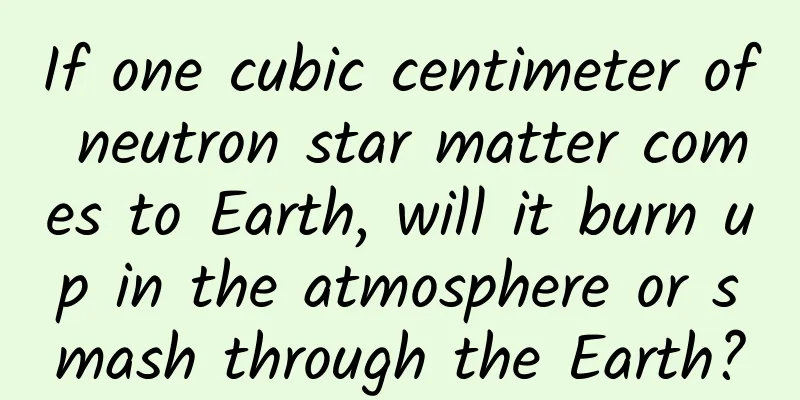If one cubic centimeter of neutron star matter comes to Earth, will it burn up in the atmosphere or smash through the Earth?

|
This article is based on answering similar questions from netizens. Neutron star matter cannot be separated from the neutron star environment, and will not come to the earth, so there is no question of whether it can be completely burned or not, and this problem has no solution. Neutron stars do not belong to the category of ordinary stars. They are the remains of stars after their death, or corpses. There are four types of stellar corpses, namely black dwarfs, white dwarfs, neutron stars, and black holes. Black dwarfs are the corpses of low-mass stars, red dwarfs. Due to the extremely long lifespan of red dwarfs, such corpses have not yet existed; white dwarfs are the corpses of small and medium-sized stars of the sun type. There are many in the universe, accounting for about 10% of the total number of stars; neutron stars are the corpses of medium-to-large mass stars with 8 to 30 times the mass of the sun, and black holes are the corpses of stars with a mass of 30 to 40 times or more. White dwarf and neutron star matter is a special degenerate matter The so-called degenerate state is that under extreme pressure, the atoms that make up the normal matter of the earth are crushed and become a special dense matter. Atoms are originally composed of atomic nuclei and peripheral electrons. The atomic nucleus occupies 99.96% of the mass of the atom, but its volume is only hundreds of billions to trillionths of the atom. This means that there is a huge space between the nucleus and the outer shell of the electrons, so once the atoms are crushed, the matter becomes very dense. This is why the density of matter in white dwarfs and neutron stars is extremely high. According to the Pauli exclusion principle of quantum mechanics, fermion particles have the property of mutual repulsion, just like children don't want to squeeze together when playing, and repel each other when they get close. Electrons, protons, and neutrons are all fermion particles, so when the outer shell of an atom's electrons is crushed, these elementary particles repel each other and try not to get close to each other. This mutual repulsion will form a kind of pressure, which is called degeneracy pressure. The deeper the degeneracy pressure is, the greater it is. White dwarfs rely on electron degeneracy pressure to support the huge gravitational pressure. That is, the electron shell of the atom still exists, but it is compressed. When it is compressed to a certain extent, the incompatibility between electrons forms a certain support force, which resists the gravitational pressure and keeps a certain space between the nucleus and the electrons, so that the nucleus remains intact. In this way, the density of white dwarfs is only 1~10 tons/cm^3, which is much lower than that of neutron stars. When the white dwarf reaches the Chandrasekhar limit, which is 1.44 times the mass of the sun, the electron degeneracy pressure can no longer support the increased gravitational pressure. The electron degeneracy pressure is destroyed, and the space between the electron and the nucleus disappears. The electron is helplessly compressed into the nucleus. Electrons carry negative charges, while protons in the nucleus carry positive charges. The number of electrons in the outer part of an atom is exactly the same as the number of protons in the nucleus. Once the positive and negative charges are neutralized, the protons also become neutrons. The nucleus is originally a combination of neutrons and protons bound together by strong forces. Now that the protons have also become neutrons, the entire planet has become a large neutron nucleus composed entirely of neutrons. Therefore, this planet is a neutron star. The neutron degeneracy pressure between neutrons is stronger than that between electrons, which barely supports the form of neutron stars. Therefore, the density of neutron stars is equivalent to that of atomic nuclei, or even denser than atomic nuclei. This kind of matter is called neutron degenerate matter. A white dwarf is about the size of the Earth, with a mass between 0.5 and 1.44 times that of the Sun. A neutron star has a mass between 1.44 and 3 times that of the Sun, but a radius of only about 10 km. As a result, its density is much higher than that of a white dwarf, reaching about 1 billion tons per cubic centimeter. When the mass of the neutron star becomes larger and reaches the Oppenheimer limit, which is about 3 solar masses or more, the neutron degeneracy pressure formed by the repulsive force between neutrons will no longer be able to support the strong gravitational pressure and will be suddenly compressed. The professional term is collapse or collapse, becoming a quark star supported by a deeper degeneracy pressure, or directly collapsing into a black hole. So far, people have not discovered the existence of quark stars, so it is generally believed that when the mass of a neutron star exceeds the Oppenheimer limit, it will directly collapse into a black hole. The so-called Chandrasek limit and Oppenheimer limit, as well as the Pauli exclusion principle, have been introduced many times in past articles, so I will not repeat them here. Neutron degenerate matter cannot exist outside of a neutron star From the above-mentioned conditions for the formation of white dwarfs and neutron stars, we can conclude that no matter whether it is electron degenerate matter or neutron degenerate matter, it is impossible to exist independently without the conditions in which they exist. Because once they are separated from the specific conditions, the huge gravitational pressure of their existence will no longer exist, and these substances will not be able to maintain the degenerate pressure, but will quickly expand and return to the atomic state, becoming the normal matter composed of neutral atoms that exists on our earth. White dwarfs and neutron stars are both celestial bodies with extremely harsh environments. With the current scientific and technological knowledge of human beings, we can only observe them from a distance, but cannot get close to them. Neutron stars are especially terrifying, with gravity second only to black holes. The surface gravity can reach hundreds of billions of times that of the earth, and the maximum escape velocity needs to reach half the speed of light, that is, 150,000 km/s. Let alone a spacecraft, if a person is captured and pulled by the gravity of a neutron star, and finally hits the surface of the neutron star at high speed, the energy can reach the power of hundreds of millions of tons of high explosives, which is about the power of 20,000 Hiroshima atomic bombs. Even such a terrifying explosion will be suppressed by the strong gravity on the neutron star, and the height of the waves it stirs up is not as high as a speck of dust. The temperature of a neutron star can reach hundreds of billions to trillions of degrees, the atmospheric pressure on the surface is 10^21 times (10 trillion times) greater than the pressure at the center of the Earth, and the magnetic field is billions of times stronger than that of the Earth. Since neutron stars inherit the angular momentum of their original stars, they generally rotate at high speeds, with the fastest speed reaching thousands of revolutions per second. Since their magnetic poles are offset from their rotation axes at a certain angle, powerful electromagnetic pulses are like rotating lighthouses, constantly sweeping into space. When they pass over the Earth, they are captured by radio telescopes and become discovered pulsars. Therefore, the so-called pulsar is the name given to the electromagnetic pulse signal of a neutron star sweeping across space and captured by humans. Under such extreme conditions of strong gravity and pressure, the surface of a neutron star is so smooth that there is not even a speck of dust. How could matter fall off from the neutron star? Changes of neutron-degenerate matter after leaving a neutron star So far, there is only one relatively certain way for neutron degenerate matter to escape from a neutron star, and that is a collision between neutron stars. As for whether a neutron star will explode when its accretion mass reaches its upper limit, ejecting neutron degenerate matter from the neutron star, there is no observational or research data in this regard. On August 17, 2017, scientists discovered gravitational waves caused by the collision of two neutron stars 130 million light years away from us, and observed a powerful gamma-ray burst. Through scientific modeling, scientists believe that the fragments of the collision of the two neutron stars in this gravitational wave event, numbered GW170817, formed some light elements such as hydrogen and helium, as well as heavy metal elements such as gold, silver, copper, iron, tungsten, nickel and lead, among which the gold is as much as 300 Earth masses. Don't think that 300 Earth masses are a lot, it's just a small loss for a neutron star. The lower limit of a neutron star's mass is 1.44 times the mass of the sun, while the mass of the earth is only 1/330,000 of the sun. The collision of two neutron stars knocked off 300 Earth masses, which is only a few thousandth of their total mass. It can be seen that once the neutron degenerate matter escapes from the neutron star and loses the strong gravitational pressure, it will become normal matter. However, they do not suddenly become normal matter after escaping from the neutron star. Instead, there is a process. First, the neutron degenerate matter that is hit and escapes will expand rapidly once it leaves the gravitational pressure of the neutron star. The expanded volume will reach thousands to tens of thousands of times the original volume. This expansion will of course be accompanied by an explosion. This is the first explosion. After the first explosion, the matter at this time is not normal matter, but just a cluster of neutrons, still in the neutron state. At this time, beta decay is taking place inside them. This process takes about 15 minutes. When this process is completed, there will be a greater expansion, that is, a more violent explosion. In the explosion, the matter returns to normal and forms various substances on Earth composed of neutral atoms. It is generally believed that the precious metals such as gold on Earth mainly come from events such as the universe. These precious metals float in the universe, condensed into the depths of the Earth when the Earth was formed, or entered the Earth's crust in the form of meteor showers. Today, these precious metals floating in space can also fall to Earth in the form of meteorites. Therefore, it is impossible for neutron star matter to enter the Earth's atmosphere. At this point, everyone should have understood why it is impossible for neutron star matter to enter the Earth's atmosphere, right? It is now known that the nearest neutron star to us is hundreds to thousands of light years away. The only condition for neutron star matter to escape from a neutron star is for the neutron stars to collide with each other. The fragments of the collision will decay into normal matter in 15 minutes. So how could there be such a high density of neutron degenerate matter in the sky above the Earth? Since there is no such thing, it is meaningless to talk about what would happen if it enters the atmosphere. But some people insist on pursuing it, so I will imagine what would happen if a spoonful of neutron star matter decayed in the atmosphere? Then it is definitely not a question of whether the neutron star matter can be completely burned, but whether the earth will be burned up. We assume that this piece of neutron degenerate matter is 1 cubic centimeter. Generally speaking, when neutron star matter decays and transforms into matter, there will be a mass loss, which is similar to nuclear fission, about 0.1%. If the density of this neutron star matter is 1 billion tons/cm^3, the mass loss in the process of decaying into normal matter is about 1 million tons. The lost matter will be converted into energy and released. According to Einstein's mass-energy equation E=MC^2, this energy is about 9*10^25J (joules), which is equivalent to the explosive power of 215 million tons of TNT (the energy of each ton of explosives is about 4184,000,000J), which is the power of about 165 billion Hiroshima atomic bombs (each with a TNT equivalent of about 13,000 tons) exploding at the same time. The total equivalent of nuclear warheads currently owned by countries around the world is only about 10 billion tons of TNT. The energy released by 1 cubic centimeter of neutron star matter is equivalent to more than 200 million times the total amount of nuclear bombs owned by humans, or equivalent to the impact power of 215 asteroids that hit the earth 65 million years ago and caused the extinction of dinosaurs. In such an explosion, fungi would probably be blown to death, let alone humans. Are you satisfied with my answer? Welcome to discuss, thank you for reading. The copyright of Space-Time Communication is original. Infringement and plagiarism are unethical behavior. Please understand and cooperate. |
Recommend
iFLYTEK Conference Mouse M610 Review: An all-around tool for offices, classrooms, and conference rooms
The mouse has become an important accessory in co...
Monthly sales of tens of millions Douyin live broadcast account full set of teaching, natural flow + Qianchuan flow + short video traffic, three-frequency resonance to explode the live broadcast room traffic
Monthly sales of tens of millions of Douyin live ...
How to break through in brand marketing?
1. Market Segmentation In today's diversified...
What happened to those who wore contact lenses for many years? 4 injuries are hard to avoid →
Many people are familiar with contact lenses, and...
Cadillac Minister Feng Dan calls for anti-counterfeiting on Pinduoduo: refurbished cars, fakes
"Refurbished cars, fakes." Shanghai'...
How to promote video account? How to attract traffic and promote video accounts?
Since the launch of the WeChat short video functi...
Content operation: Learn the basic routines and play it however you want
Today, I will share with you how to do content ma...
Is attracting new users a big problem? Maybe the wrong medicine was used.
What is user acquisition? "Attracting new us...
Case review: How did you acquire 100,000 users in 3 days?
Want to know the secret to gaining 100,000 users ...
Understand information flow advertising in one article! A must-read for promotion novices!
Recently, due to work needs ( Internet marketing ...
How to operate “private domain traffic” in circle of friends!
The topic of private domain traffic has become in...
#千万IP创科学普# The secret of maritime safety, Fuchuan will tell you
The manufacturing technology of Chinese watertigh...
Practical tips | How to do marketing promotion on Douban
What I want to share with you today are some of m...
With the lead rate declining, how can the franchise industry save itself after the epidemic?
During the epidemic, some people waited while oth...
How to improve SEO ranking? How to rank in the top three on the SEO homepage?
When you search for a certain keyword, there will...









